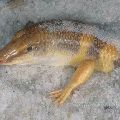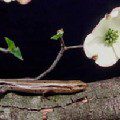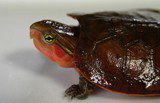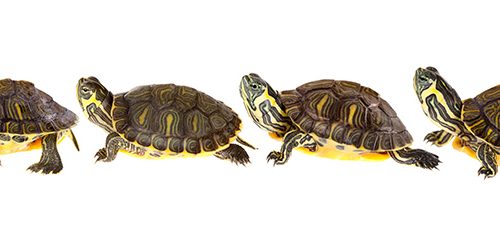
Japanese skink
The Japanese skink belongs to the genus of long-legged skinks – large lizards with a long tail, capable of reaching 40 cm in size. This reptile is thermophilic and, in suitable conditions, is extremely mobile. She has strong hind limbs, so the lizard is able to jump well and even climb trees, which it sometimes does, although it leads a predominantly terrestrial lifestyle. As for living conditions, here the Japanese skink, like other representatives of the genus, is quite unpretentious. It is mainly found in the mountains and foothills, on rocky slopes and in the beds of dry rivers, as well as in coastal river thickets and near cliffs. Sometimes this lizard settles in the ruins of various structures and on the outskirts of fields.
Contents
Classification
Kingdom of Animals
Type Chordates
Class Reptiles or Reptiles
Squad order
Suborder Lizards
Skink family
Genus Long-legged Skinks
View Japanese skink, Eumeces latisculatus
Appearance
 The Japanese skink is not the largest member of the long-legged skink genus. In length, it reaches only 18-20 cm. However, all other generic features of the lizard are characteristic in full. In particular, her five-fingered limbs are well developed, her skin is smooth and as if varnished, her eyes are framed by separate movable eyelids, in the lower of which there is no transparent window characteristic of other reptiles. The auditory canal of the Japanese skink is open, and the eardrum is located in depth. The tail of the reptile is long and is characterized by autotomy – the ability to easily discard it in case of danger. The structure of the head of the Japanese skink is also peculiar – there are enlarged areas on the temples, the intermaxillary shield is raised to the upper part of the muzzle and reaches the upper nasal shields. The frontal scales are shorter than the interparietal scales, there are several pairs of nape scales in the back of the head, and triangular scutes frame the ear in front. From below, on the tail of the Japanese skink, a longitudinal row of scales noticeably expanded compared to the rest of the scales stands out. The body of the lizard is slender, dark brown, almost black on top, with light longitudinal stripes disappearing towards the tail. In adult Japanese skinks, these stripes disappear altogether, and the overall coloration becomes olive-gray. Only fairly wide dark areas stand out on the sides. Sexual dimorphism is present, but not very pronounced.
The Japanese skink is not the largest member of the long-legged skink genus. In length, it reaches only 18-20 cm. However, all other generic features of the lizard are characteristic in full. In particular, her five-fingered limbs are well developed, her skin is smooth and as if varnished, her eyes are framed by separate movable eyelids, in the lower of which there is no transparent window characteristic of other reptiles. The auditory canal of the Japanese skink is open, and the eardrum is located in depth. The tail of the reptile is long and is characterized by autotomy – the ability to easily discard it in case of danger. The structure of the head of the Japanese skink is also peculiar – there are enlarged areas on the temples, the intermaxillary shield is raised to the upper part of the muzzle and reaches the upper nasal shields. The frontal scales are shorter than the interparietal scales, there are several pairs of nape scales in the back of the head, and triangular scutes frame the ear in front. From below, on the tail of the Japanese skink, a longitudinal row of scales noticeably expanded compared to the rest of the scales stands out. The body of the lizard is slender, dark brown, almost black on top, with light longitudinal stripes disappearing towards the tail. In adult Japanese skinks, these stripes disappear altogether, and the overall coloration becomes olive-gray. Only fairly wide dark areas stand out on the sides. Sexual dimorphism is present, but not very pronounced.
Males are generally brighter colored and larger in size. On some parts of their body they can stand out in some bright shade – reddish or orange. And, of course, the base of the tail in male Japanese skinks is thickened, as in most male reptiles. Sometimes a lizard of this species is mistakenly confused with the Far Eastern skink – Plestiodon latiscutatus. However, it should be noted that reptiles belong to completely different genera. The Far Eastern skink is from the Plestiodon genus, and the Japanese skink is from the long-legged genus. Perhaps the confusion occurs because both of these genera are generally similar in characteristics. On the other hand, these skinks intersect habitat, which is also fraught with their erroneous perception.
Distribution and habitation
There is no need to guess about the habitat of the Japanese skink. Of course, it is found on the Japanese islands and also on the island of Kunashir, where another rare species of lizard lives – the Far Eastern skink. Occasionally, the Japanese skink happened to be met in the Far East. The terrestrial lifestyle obliges him to choose suitable biotopes, which are rocky places, occasionally overgrown with shrubs, or forests, where it is sometimes possible to climb trees. By the way, as a separate species, the Japanese skink was discovered and described precisely on the island of Kunashir. Today it can be found on clay and stone soils, in the foothills and on the plains, in semi-steppes and semi-deserts. Olive and pistachio groves, slopes of ravines, valleys of streams and rivers, roadsides, cultural plantations, vineyards, agricultural land, the ruins of buildings on the outskirts of cities – everywhere the Japanese skink easily finds shelter. And at the same time, this species is considered one of the rarest in the genus. Also, the Japanese skink is able to climb mountains to a height of up to 1500 meters above sea level.
Behavior and lifestyle
 Female Japanese skinks, slender and with a narrower skull, are rarely seen. Males are much more active. These lizards tend to hibernate, not only in summer but also in winter. And such a summer numbness is quite capable of developing into a winter one. But even outside of hibernation, it is rarely possible to see the Japanese skink, since it spends a lot of time in various shelters – rodent burrows, cracks in the soil, stone rubble, or even long depressions dug independently, up to half a meter deep. Japanese skinks are territorial creatures and are loners by nature. They cannot be called particularly aggressive, although many representatives of the genus are just that. However, the Japanese skink is able to defend itself actively and can bite sensitively with its strong jaws when trying to pick it up. At the same time, Japanese lizards can be kept in a terrarium in pairs, while typical long-legged skinks are recommended to be planted one at a time. And of course, they are somewhat easier to tame than other relatives.
Female Japanese skinks, slender and with a narrower skull, are rarely seen. Males are much more active. These lizards tend to hibernate, not only in summer but also in winter. And such a summer numbness is quite capable of developing into a winter one. But even outside of hibernation, it is rarely possible to see the Japanese skink, since it spends a lot of time in various shelters – rodent burrows, cracks in the soil, stone rubble, or even long depressions dug independently, up to half a meter deep. Japanese skinks are territorial creatures and are loners by nature. They cannot be called particularly aggressive, although many representatives of the genus are just that. However, the Japanese skink is able to defend itself actively and can bite sensitively with its strong jaws when trying to pick it up. At the same time, Japanese lizards can be kept in a terrarium in pairs, while typical long-legged skinks are recommended to be planted one at a time. And of course, they are somewhat easier to tame than other relatives.
Over time, you can even achieve that the Japanese skink began to take food directly from the hands. As heat-loving reptiles, these lizards need a constant ambient temperature of at least 28 degrees during the day and 20 degrees at night. They are not as demanding on humidity as the lizards that live in the tropics, but still once a day you should spray the terrarium with warm water. But, like other skinks, Japanese skinks are characterized by basking – the ability to raise body temperature by absorbing solar heat. So local heating in the terrarium is necessary, and it is better that it be an incandescent lamp and, in addition to it, additional heat sources – a thermal stone, a thermal cable or a thermal mat.
Food
In nutrition, the Japanese skink does not show any special preferences. It can hunt various invertebrates and insects, catch smaller reptiles and eat the fruits of various plants. A particularly favorite delicacy is mulberry. Rough food, such as mollusks in shells or spiders with a hard chitinous cover, Japanese skinks crush with powerful jaws. If the prey is large, then the lizard can fiddle with it for a long time, crushing and crushing it before swallowing it. In search of water, Japanese skinks are able to travel long distances. Scientists happened to observe how they quickly get from their holes to a reservoir located a few tens of meters away. But moisture also enters the body of lizards along with juicy food, for example, fruits and fleshy leaves of some suitable plants.
Feeding the Japanese skink in a terrarium is quite simple due to its unpretentiousness. He will be happy to eat various crickets and exotic cockroaches, flour worms and zoophobas, other insects, snails, slugs and even small mice. It is advisable to diversify the lizard’s diet with various berries, fruits or leaves, such as dandelion. Some breeders feed skinks with small pieces of raw meat. Feeding young animals is practically no different from an adult, except perhaps smaller portions. Suitable diet – at least once every two days, you can daily, preferably a variety of food. Japanese skinks also need water. It is better to change it into a drinking bowl every day, or you can add mineral water, for example, Borjomi. Plus, various mineral supplements, which can be replaced by crushed eggshells – skinks need calcium. Once a month, they should be given special vitamin preparations, and other specialized feeding for reptiles should be given only according to indications.
Reproduction
 Unfortunately, the reproduction of Japanese skinks has not been sufficiently studied, and data on it are made on the basis of assumptions obtained from observations of other representatives of the genus. In particular, it is assumed that Japanese skinks tend to take care of their offspring. The female makes a clutch, and then wraps around her, guarding. And even eats nearby. Or, basking in the sun, wraps around the eggs, giving them its warmth. Moreover, such care can last up to 2-3 weeks, until the young hatch. Similar characteristics apply to the North American mountain skink, and in the common American species, the female even periodically turns the eggs, licks them with her tongue and helps the babies to get out of the egg shell when the time comes. In the first days of life, the skink mother is even capable of giving up her food to the young.
Unfortunately, the reproduction of Japanese skinks has not been sufficiently studied, and data on it are made on the basis of assumptions obtained from observations of other representatives of the genus. In particular, it is assumed that Japanese skinks tend to take care of their offspring. The female makes a clutch, and then wraps around her, guarding. And even eats nearby. Or, basking in the sun, wraps around the eggs, giving them its warmth. Moreover, such care can last up to 2-3 weeks, until the young hatch. Similar characteristics apply to the North American mountain skink, and in the common American species, the female even periodically turns the eggs, licks them with her tongue and helps the babies to get out of the egg shell when the time comes. In the first days of life, the skink mother is even capable of giving up her food to the young.
The number of eggs in the clutch of the Japanese skink is about 5-9 pieces. Their laying occurs, presumably, in the middle of summer. Sexual maturity occurs after one and a half to two years of life.
In captivity, the reproduction of skinks begins after the removal of their artificial wintering. Then the lizards are irradiated and fed with food with the addition of vitamin E. After two or three weeks, individuals of different sexes are planted next to each other. The gestation time of female Japanese skinks is about 2 months, then they need a moist substrate to build a nest. Moreover, in nature, the female will be nearby during the entire incubation period, the same 2-3 months. But in the terrarium, the eggs are removed and placed in an incubator.
The born young begin to feed on their own after they have absorbed the entire available yolk reserve.
It is most active in spring and autumn – during the day, and in summer, when the weather is especially hot – in the mornings and evenings. However, it is not easy to see the Japanese skink, as it is a rather secretive creature. Unless during the breeding season, when the lizards come out of their holes, where they spend most of their lives. In terrarium collections, this species is not particularly popular only because it can be called relatively new – the Japanese skink in the genus of long-legged skinks was the most recently discovered. However, the large size, iridescent scales and lively disposition of long-legged skinks have long been recognized among terrariumists. These reptiles come to nurseries from wildlife and often after long-term transportation, and because of this, skinks often have health problems. However, they are distinguished by survivability and easily adapt to even the most primitive conditions. However, if you plan to breed Japanese skinks, then providing them with a favorable environment is a must. These lizards, like other representatives of the genus, are distinguished by a pronounced seasonal cycle, which is expressed in ups and downs in their activity. And if you do not follow their natural “mode”, then the skinks may be on the verge of exhaustion.
Sources of
http://dic.academic.ru/
http://www.VitaWater.ru/
http://www.ecosystema.ru/
http://zookaraganda.narod.ru/
http://ru.wikipedia.org/
http://www.pitomcev.net





